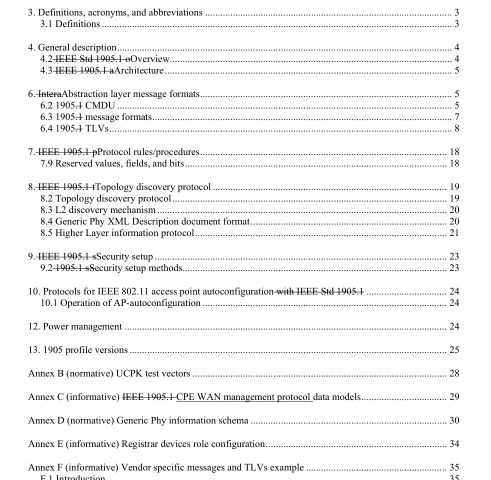IEEE 1905.1a-2014 pdf download.IEEE Standard for a Convergent Digital Home Network for Heterogeneous Technologies Amendment 1 : Support of New MAC/PHYs and Enhancements
3. Definitions, acronyms, and abbreviations
3.1 Definitions Delete Footnote 16.
Change the following definitions in 3.1: 1905.1 device 3 : A device with one or more interfaces abstracted by a 1905.1 abstraction layer.
1905.1 management entity: An entity responsible for generating and processing 1905.1 inter abstraction layer messages. reserved (bits)field: Bit A fields of bits reserved for future revisions of this specification. u-key: A generic term to refer to the privacy parameter of each underlying 1905.1 network technology: Wi-Fi wireless protected access (WPA)/wireless protected access II (WPA2) passphrase, IEEE 1901 shared key device-based security network (DSNA) network membership key (NMK), IEEE 1901 pairwise security network (PSNA) pairwise key (PWK), and MoCA privacy password. For Generic Phy, the u-key is derived as expressed in the UKeyDerivation element. Insert the following definitions alphabetically in
3.1: Behind MAC Address: An L2 MAC address discovered through a logical link discovery mechanism specific to the underlying technology that is behind the L2 Neighbor Device relative the discovering device. Generic Phy: An underlying network interface technology identified by a Media type of 0xFFFF, IEEE OUI, Variant index, and XML Description document.
L2 Neighbor Device: A device discovered through a L2 discovery mechanism specific to the underlying technology that is a direct L2 neighbor of the discovering device.
4. General description
Change the title of 4.2:
4.2 IEEE Std 1905.1 oOverview
Change the first paragraph in 4.2:
IEEE Std 1905.1This standard defines an abstraction layer that provides a common interface to several home network technologies: IEEE 1901 over power lines, Wi-Fi/IEEE 802.11 for wireless, Ethernet over twisted pair cable, and MoCA 1.1 over coax (see Figure 4-1). Other network technologies are supported by an extensible mechanism using an IEEE OUI and an XML-formatted document. (See Figure 4-1.)
Change the title of 4.2.1:
4.2.1 Benefits of IEEE Std 1905.1
Insert the following unordered list items at the end of the unordered list in 4.2.1:
— Extensibility: Other network technologies are supported by an extensible mechanism using an IEEE OUI and an XML-formatted document.
— Higher Layer reporting
— Power management of interfaces
— L2 Neighbor Device discovery reporting
6.3 1905.1 message formats
6.3.3 Topology response message format
Insert the following unordered list items at the end of the unordered list in 6.3.3:
Zero or more Power off interface TLVs (see Table 6-38)
If a 1905 device that implements the Power off interface TLV has an interface that is in the state of PWR_OFF, then the 1905 management entity shall include the interface in the Power off interface TLV.
Zero or more L2 neighbor device TLVs (see Table 6-41)
If a 1905 management entity infers the presence of a L2 Neighbor Device (see 8.3), then the 1905 management entity shall include that device in the L2 neighbor device TLV.
6.3.11 1905.1 push button event notification message format
Insert the following unordered list items at the end of the unordered list in 6.3.11:
Zero or one Push_Button_Generic_Phy_Event notification TLV (see Table 6-36)
If at least one intfType in the Push_Button_Event notification TLV is Generic Phy, then a 1905 management entity shall include that event in the Push_Button_Generic_Phy_Event notification TLV.
6.3.13 Vendor specific message format
Insert 6.3.14 through 6.3.19 after 6.3.13:
6.3.14 Generic Phy query message format
No TLVs are required in this message.
6.3.15 Generic Phy response message format
The following TLV shall be included in this message:
One Generic Phy device information type TLV (see Table 6-29)
6.3.16 Higher Layer query message format
No TLVs are required in this message.
6.3.17 Higher Layer response message format
The following TLVs shall be included in this message:
— One 1905 AL MAC address type TLV (see Table 6-8)
— One 1905 profile version TLV (see Table 6-37)
— One Device identification type TLV (see Table 6-30)
— Zero or one Control URL type TLV (see Table 6-31)
— Zero or one IPv4 type TLV (see Table 6-32)
If a 1905 device has an IPv4 address, then the 1905 management entity shall include the IPv4 address information in the IPv4 type TLV.
— Zero or one IPv6 type TLV (see Table 6-34)
If a 1905 device has an IPv6 address, then the 1905 management entity shall include the IPv6 address information in the IPv6 type TLV.IEEE 1905.1a pdf download.IEEE 1905.1a-2014 pdf download
IEEE 1905.1a-2014 pdf download

Leave a Reply